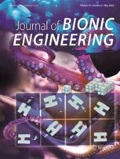Abstract
An omnidirectional mobile robot has the advantage that three degrees of freedom of motion in a 2D plane can be set independently, and it can thus move in arbitrary directions while maintaining the same heading. Dead reckoning is often used for self-localization using onboard sensors in omnidirectional robots, by means of measuring wheel velocities from motor encoder data, as well as in car-like robots. However, omnidirectional mobile robots can easily slip because of the nature of omni-wheels with multiple free rollers, and dead reckoning will not work if even one wheel is not attached to the ground. An odometry method where the data is not affected by wheel slip must be introduced to acquire high quality self-location data for omnidirectional mobile robots. We describe a method to obtain robot ego-motion using camera images and optical flow calculation, i.e., where the camera is used as a velocity sensor. In this paper, a silicon retina vision camera is introduced as a mobile robot sensor, which has a good dynamic range under various lighting conditions. A Field-Programmable Gate Array (FPGA) optical flow circuit for the silicon retina is also developed to measure ego-motion of the mobile robot. The developed optical flow calculation system is introduced into a small omnidirectional mobile robot and evaluation experiments for the mobile robot ego-motion are carried out. In the experiments, the accuracy of self-location by the dead reckoning and optical flow methods are evaluated by comparison using motion capture. The results show that the correct position is obtained by the optical flow sensor rather than by dead reckoning.
Similar content being viewed by others
References
Sanada A, Takemura Y, Ishii K, Nassiraei A A F, Godler I, Kitazumi Y, Ogawa Y. Development of omnidirectional mobile robot for RoboCup middle size league team. SICE System Integration 2009, Japan, 2009, 2BI-2 (in Japanese).
Takemura Y, Sanada A, Ichinose T, Nakano Y, Nassiraei A A F, Azeura K, Kitazumi Y, Ogawa Y, Godler I, Ishii K. Development of “Hibikino-Musashi” omnidirectional mobile robot. International Congress Series, 2007, 1301, 201–205.
Nassiraei A A F, Takemura Y, Sanada A, Kitazumi Y, Ogawa Y, Godler I, Ishii K, Miyamoto H, Ghaderi A. Concept of mechatronics modular design for an autonomous mobile soccer robot. International Symposium on Computational Intelligence in Robotics and Automation “CIRA 2007”, Jacksonville, USA, 2007, 178–183
Shi J, Tomasi C. Good features to track. IEEE Conference on Computer Vision and Pattern Recognition, Seattle, USA, 1994, 593–600.
Barron J L, Fleet D J, Beauchemin S S. Performance of optical flow techniques. International Journal of Computer Vision, 1994, 12, 43–77.
Kameda S, Yagi T. An analog VLSI chip emulating sustained and transient response channels of the vertebrate retina. IEEE Transactions on Neural Networks, 2003, 14, 1405–1412.
Shimonomura K, Yagi T. Computing lightness constancy with an APS-based silicon retina. IEEE Biomedical Circuits and Systems Conference “BioCAS 2008”, Baltimore, MD, USA, 2008, 201–204.
Mead C. Analog VLSI and Neural Systems, Addison-Wesley, Reading, MA, USA, 1989.
Gyaourova A, Kamath C, Cheung S C. Block matching for object tracking. LLNL Technical Report, 2003, UCRL-TR-200271.
Di Stefano L, Viarani E. Vehicle detection and tracking using the block matching algorithm. In: Mastorakis N (ed). Recent Advances in Signal Processing and Communications, World Scientific and Engineering Society Press, Athens, Greece, 1999.
Bierling M. Displacement estimation by hierarchical block matching. Proceedings of the SPIE Conference, 1988, 1001, 942–951.
Horn B K P, Schunck B G. Determining optical flow, Artificial Inteligence, 1981, 17, 185–203.
XILINX. XtremeDSP for Virtex-4 FPGAs User Guide, [2010-07-01], http://www.xilinx.com/
Takemura Y, Sato M, Ishii K. Toward realization of swarm intelligence mobile robots. International Congress Series, 2006, 1291, 273–276.
Author information
Authors and Affiliations
Corresponding author
Rights and permissions
About this article
Cite this article
Sanada, A., Ishii, K. & Yagi, T. Self-Localization of an Omnidirectional Mobile Robot Based on an Optical Flow Sensor. J Bionic Eng 7 (Suppl 4), S172–S176 (2010). https://doi.org/10.1016/S1672-6529(09)60232-8
Published:
Issue Date:
DOI: https://doi.org/10.1016/S1672-6529(09)60232-8




